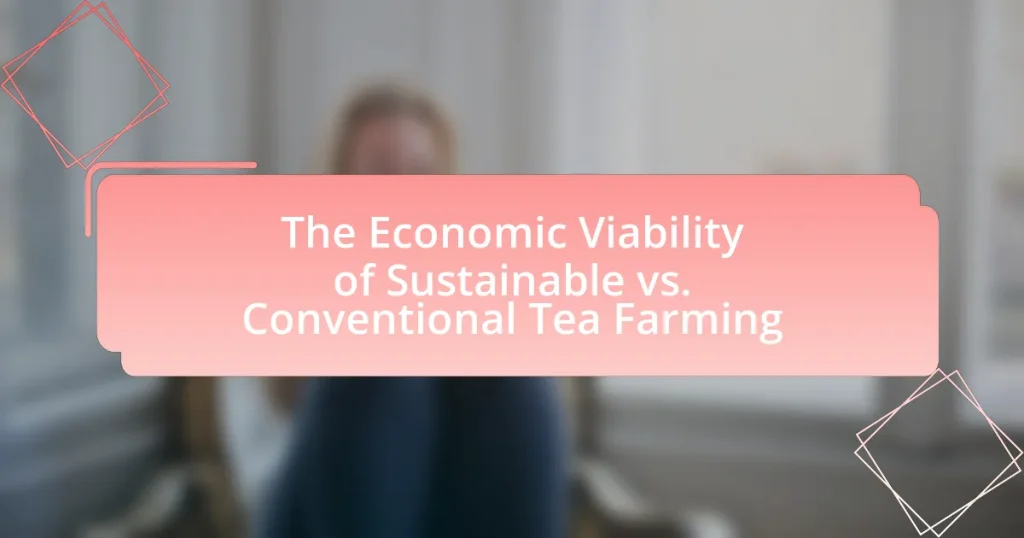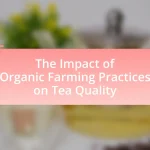The article examines the economic viability of sustainable tea farming compared to conventional tea farming. It highlights that while sustainable practices may incur higher initial costs, they generally lead to greater long-term economic benefits, including improved soil health, reduced input costs, and premium market prices due to rising consumer demand for ethically produced products. Key discussions include the differences in operational costs, potential financial returns, and the impact of market demand on profitability. Additionally, the article addresses the challenges farmers face in adopting sustainable practices, the role of regulatory frameworks, and the broader implications for local economies and environmental sustainability.
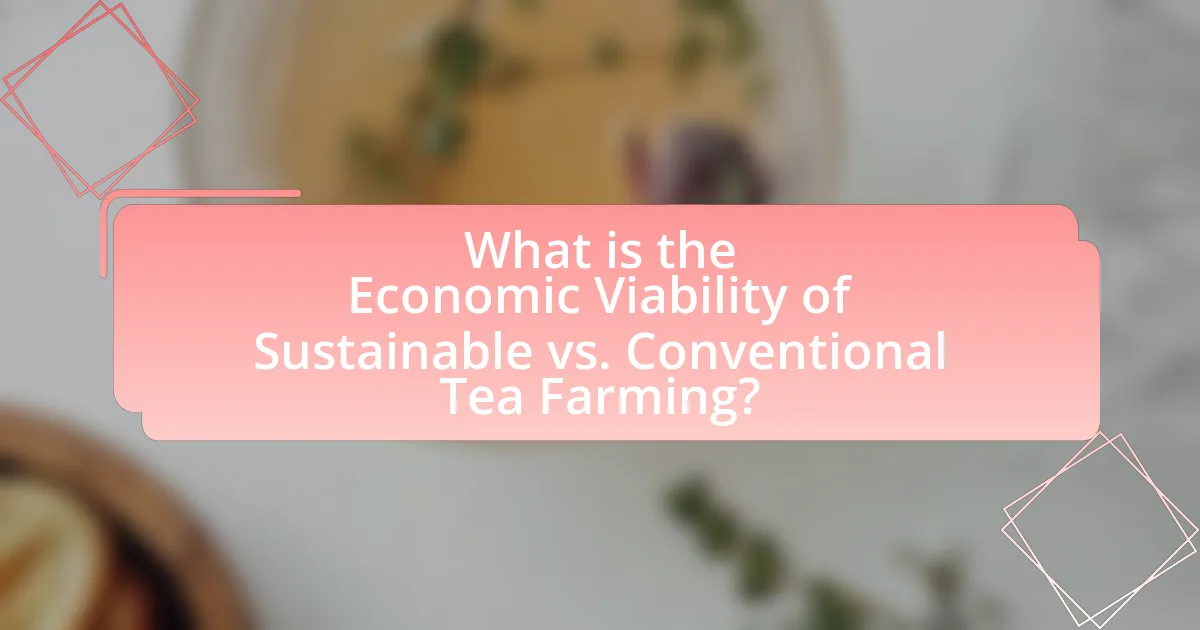
What is the Economic Viability of Sustainable vs. Conventional Tea Farming?
The economic viability of sustainable tea farming is generally higher in the long term compared to conventional tea farming. Sustainable practices often lead to improved soil health, reduced input costs, and better market prices due to consumer demand for ethically produced products. For instance, a study published in the Journal of Sustainable Agriculture found that organic tea farms can yield up to 20% higher prices per kilogram than conventional farms, reflecting consumer willingness to pay for sustainability. Additionally, sustainable farming methods can reduce dependency on chemical inputs, leading to lower operational costs over time.
How do sustainable and conventional tea farming practices differ economically?
Sustainable tea farming practices generally incur higher initial costs but can lead to greater long-term economic benefits compared to conventional tea farming. Sustainable practices often require investments in organic inputs, certification processes, and training for farmers, which can increase upfront expenses. However, these practices can enhance soil health, reduce dependency on chemical inputs, and improve biodiversity, leading to higher yields and better quality tea over time.
In contrast, conventional tea farming typically relies on synthetic fertilizers and pesticides, which may lower immediate costs but can lead to soil degradation and increased vulnerability to pests and diseases, ultimately affecting long-term productivity. Research indicates that sustainable tea farms can achieve price premiums for their products, with consumers increasingly willing to pay more for ethically sourced and environmentally friendly tea. For instance, a study published in the Journal of Sustainable Agriculture found that organic tea farmers in India received prices up to 30% higher than their conventional counterparts, demonstrating the economic viability of sustainable practices in the tea industry.
What are the initial investment costs for sustainable tea farming?
The initial investment costs for sustainable tea farming typically range from $5,000 to $10,000 per hectare. This cost includes expenses for organic certification, soil preparation, planting materials, irrigation systems, and labor. For instance, a study by the International Tea Committee highlights that organic certification can cost around $1,000 to $2,000, while quality seedlings and sustainable farming practices may add additional costs. These investments are essential for establishing a sustainable tea farm that adheres to environmentally friendly practices and meets market demand for organic products.
How do operational costs compare between sustainable and conventional tea farming?
Operational costs for sustainable tea farming are generally higher than those for conventional tea farming. This is primarily due to the increased labor requirements and the use of organic inputs, which can be more expensive than synthetic fertilizers and pesticides commonly used in conventional farming. For instance, a study published in the Journal of Agricultural Economics found that sustainable tea farms can incur operational costs that are 20-30% higher compared to their conventional counterparts, largely because of the practices involved in maintaining soil health and biodiversity.
What are the potential financial returns from sustainable tea farming?
Sustainable tea farming can yield financial returns that are often higher than conventional methods due to premium pricing, reduced input costs, and increased market demand for organic products. Research indicates that sustainable practices can lead to a 20-30% increase in profit margins compared to conventional farming, as consumers are willing to pay more for ethically sourced and environmentally friendly products. Additionally, sustainable tea farms often benefit from lower costs associated with chemical inputs and improved soil health, which can enhance yield stability over time.
How does market demand influence the profitability of sustainable tea?
Market demand significantly influences the profitability of sustainable tea by driving prices and consumer purchasing behavior. As consumers increasingly prioritize sustainability, the demand for sustainably produced tea rises, allowing producers to charge premium prices. For instance, a report from the International Trade Centre indicates that the global market for organic tea has been growing at a rate of 10% annually, reflecting a shift in consumer preferences towards environmentally friendly products. This increased demand not only enhances profit margins for sustainable tea producers but also encourages more farmers to adopt sustainable practices, further solidifying the market’s growth potential.
What premium prices can sustainable tea fetch compared to conventional tea?
Sustainable tea can fetch premium prices ranging from 10% to 50% higher than conventional tea. This price difference is attributed to increasing consumer demand for ethically sourced and environmentally friendly products. For instance, a study published in the Journal of Cleaner Production found that organic tea, which is often produced sustainably, can command prices up to 30% higher than its conventional counterparts due to its perceived health benefits and lower environmental impact.
What are the long-term economic impacts of sustainable tea farming?
Sustainable tea farming leads to long-term economic benefits such as increased profitability, enhanced market access, and improved resilience against climate change. Research indicates that sustainable practices can boost yields by up to 20% over time, as healthier soil and ecosystems support better crop production. Additionally, sustainable tea farms often gain premium prices for their products, with consumers increasingly willing to pay more for ethically sourced goods. A study by the International Institute for Environment and Development found that sustainable practices can reduce costs associated with chemical inputs and increase farmer incomes by 30% over a decade. This economic viability not only supports farmers but also contributes to local economies and promotes sustainable development in tea-producing regions.
How does sustainable farming affect soil health and productivity over time?
Sustainable farming enhances soil health and productivity over time by promoting biodiversity, improving soil structure, and increasing organic matter. Practices such as crop rotation, cover cropping, and reduced chemical inputs contribute to a more resilient soil ecosystem. Research indicates that sustainable practices can lead to a 20-30% increase in soil organic carbon, which is crucial for nutrient retention and water infiltration. Additionally, studies show that farms employing sustainable methods often experience higher yields in the long term due to improved soil fertility and reduced erosion, thereby supporting the economic viability of sustainable tea farming compared to conventional methods.
What role does sustainable tea farming play in local economies?
Sustainable tea farming significantly contributes to local economies by promoting job creation, enhancing livelihoods, and fostering environmental stewardship. This farming method often employs local labor, providing stable employment opportunities and fair wages, which can uplift communities economically. For instance, a study by the International Institute for Environment and Development found that sustainable practices can increase farmers’ incomes by up to 30% compared to conventional methods. Additionally, sustainable tea farming encourages the development of local supply chains, reducing dependency on external markets and enhancing economic resilience. By prioritizing eco-friendly practices, these farms also attract eco-tourism, further boosting local economies.
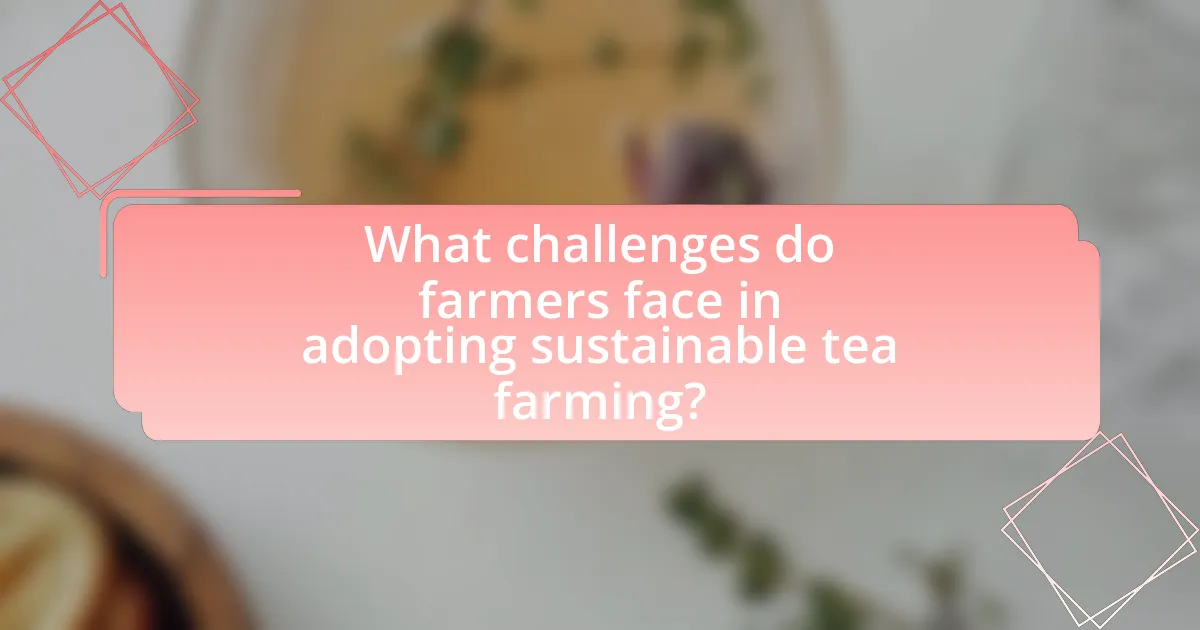
What challenges do farmers face in adopting sustainable tea farming?
Farmers face several challenges in adopting sustainable tea farming, primarily including higher initial costs, lack of access to knowledge and resources, and market demand fluctuations. The transition to sustainable practices often requires significant investment in organic inputs and training, which can be financially burdensome for smallholder farmers. Additionally, many farmers lack access to information about sustainable techniques and may not have the necessary resources or infrastructure to implement these practices effectively. Market demand for sustainably produced tea can also be inconsistent, making it difficult for farmers to secure stable prices for their products. These factors collectively hinder the widespread adoption of sustainable tea farming practices.
What are the barriers to entry for sustainable tea farming?
The barriers to entry for sustainable tea farming include high initial investment costs, lack of access to sustainable farming resources, and limited market demand for sustainably produced tea. High initial investment costs arise from the need for organic certification, sustainable farming practices, and infrastructure improvements, which can deter new farmers. Additionally, many farmers face challenges in accessing resources such as organic seeds, eco-friendly fertilizers, and training programs that promote sustainable practices. Limited market demand is evidenced by the fact that only a small percentage of tea consumers actively seek out sustainably sourced products, making it difficult for new entrants to secure profitable sales.
How do regulatory frameworks impact sustainable tea farming?
Regulatory frameworks significantly influence sustainable tea farming by establishing standards that promote environmentally friendly practices and social responsibility. These frameworks often include guidelines for pesticide use, water management, and labor rights, which encourage farmers to adopt sustainable methods that can enhance soil health and biodiversity. For instance, the Rainforest Alliance certification requires compliance with specific environmental and social criteria, leading to improved farming practices and potentially higher market prices for sustainably produced tea. Additionally, regulations can provide financial incentives or subsidies for farmers who implement sustainable practices, thereby improving their economic viability compared to conventional farming methods.
What financial risks are associated with transitioning to sustainable practices?
Transitioning to sustainable practices in tea farming involves several financial risks, including initial capital investment, potential yield reduction during the transition period, and market volatility. The initial capital investment is often substantial, as farmers may need to purchase new equipment, invest in organic inputs, or undergo certification processes, which can strain financial resources. During the transition, yields may decrease as the farm shifts from conventional to sustainable methods, impacting short-term revenue. Additionally, market volatility can arise from fluctuating consumer demand for sustainable products, which may not always guarantee higher prices compared to conventional tea. According to a study by the International Institute for Environment and Development, farmers transitioning to organic practices can experience a yield drop of 20-30% in the initial years, highlighting the financial risks associated with this shift.
How can farmers overcome challenges in sustainable tea farming?
Farmers can overcome challenges in sustainable tea farming by adopting integrated pest management (IPM) practices, which reduce reliance on chemical pesticides and promote biodiversity. Implementing IPM has been shown to decrease pest populations while maintaining crop yields, as evidenced by a study published in the Journal of Agricultural Science, which found that farms using IPM techniques had a 30% reduction in pest-related losses compared to conventional methods. Additionally, farmers can enhance soil health through organic fertilization and cover cropping, which improves nutrient availability and reduces erosion. Research from the International Tea Research Institute indicates that organic practices can lead to a 20% increase in soil fertility over five years, supporting sustainable production. By investing in training and education on sustainable practices, farmers can also improve their knowledge and skills, leading to better management of resources and increased economic viability.
What resources are available for farmers transitioning to sustainable practices?
Farmers transitioning to sustainable practices can access various resources, including government programs, non-profit organizations, and educational institutions. For instance, the USDA offers grants and technical assistance through programs like the Environmental Quality Incentives Program (EQIP), which supports farmers in implementing sustainable practices. Additionally, organizations such as the Sustainable Agriculture Research and Education (SARE) program provide funding and resources for research and education on sustainable farming methods. Universities often have extension services that offer workshops and training on sustainable agriculture techniques, further aiding farmers in their transition. These resources collectively enhance the economic viability of sustainable farming by providing financial support and knowledge essential for successful implementation.
How can collaboration among farmers enhance economic viability?
Collaboration among farmers enhances economic viability by enabling resource sharing, reducing costs, and increasing market access. When farmers work together, they can pool resources such as equipment and labor, which lowers individual expenses and improves efficiency. For instance, cooperative farming models have been shown to reduce production costs by up to 20% through shared machinery and collective purchasing of inputs. Additionally, collaboration allows farmers to access larger markets and negotiate better prices for their products, as seen in various agricultural cooperatives that have successfully increased their members’ income by 30% through collective marketing strategies. This cooperative approach not only strengthens individual farmers’ economic positions but also fosters community resilience and sustainability in agricultural practices.
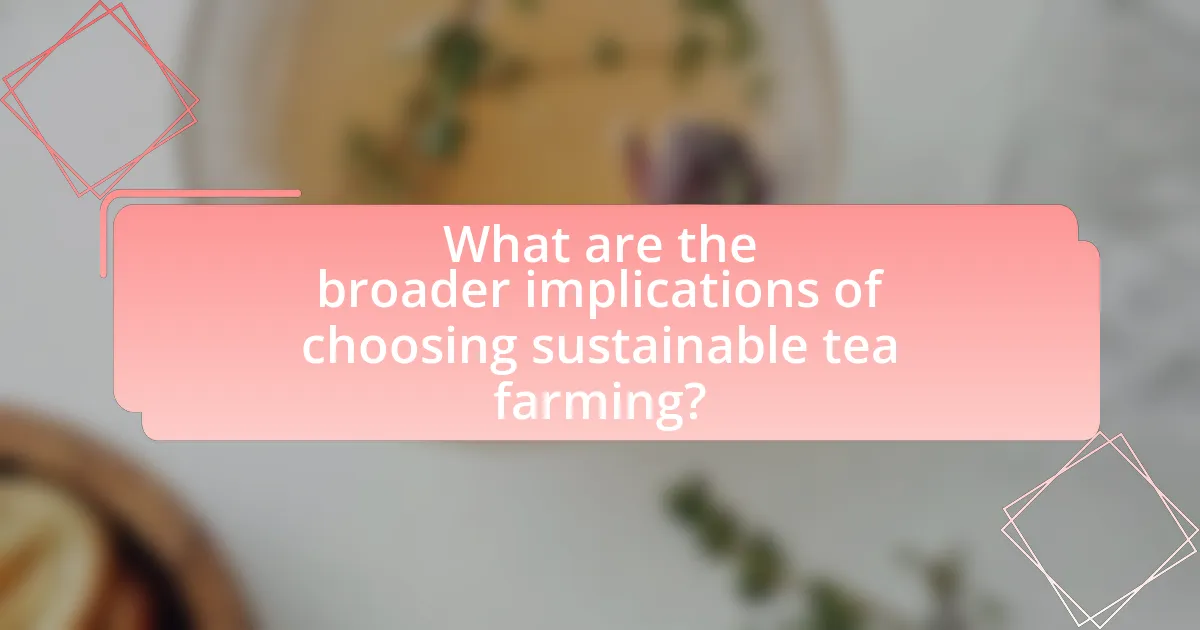
What are the broader implications of choosing sustainable tea farming?
Choosing sustainable tea farming has significant broader implications, including environmental preservation, economic stability, and social equity. Sustainable practices reduce chemical runoff, enhance biodiversity, and improve soil health, which collectively contribute to long-term ecological balance. Economically, sustainable tea farming can lead to higher market prices and increased consumer demand, as evidenced by a report from the International Trade Centre indicating that organic tea can command prices up to 30% higher than conventional tea. Socially, sustainable practices often involve fair labor conditions and community engagement, fostering better relationships between farmers and consumers. This holistic approach not only supports the livelihoods of tea farmers but also promotes a more resilient agricultural system.
How does sustainable tea farming contribute to environmental sustainability?
Sustainable tea farming contributes to environmental sustainability by promoting biodiversity, reducing chemical inputs, and enhancing soil health. This farming method often incorporates agroecological practices, such as intercropping and organic fertilizers, which support a diverse ecosystem and minimize the reliance on synthetic pesticides and fertilizers. Research indicates that sustainable practices can lead to a 30% increase in biodiversity compared to conventional methods, as they create habitats for various species. Additionally, sustainable tea farms often implement water conservation techniques, reducing water usage by up to 50%, which helps preserve local water resources. These practices collectively contribute to a healthier environment, demonstrating that sustainable tea farming is not only viable economically but also essential for ecological balance.
What are the ecological benefits of sustainable tea farming practices?
Sustainable tea farming practices provide significant ecological benefits, including enhanced biodiversity, improved soil health, and reduced chemical runoff. These practices promote the conservation of native plant and animal species by maintaining natural habitats, which supports a diverse ecosystem. For instance, organic farming methods, which are a key component of sustainable practices, avoid synthetic pesticides and fertilizers, leading to healthier soil microbiomes and increased soil fertility. Research indicates that organic tea farms can support up to 50% more biodiversity compared to conventional farms. Additionally, sustainable practices help mitigate water pollution by minimizing the use of harmful chemicals, thus protecting local waterways and aquatic life.
How does sustainable tea farming impact biodiversity?
Sustainable tea farming positively impacts biodiversity by promoting ecological balance and preserving various species. This farming method often incorporates practices such as agroforestry, which enhances habitat diversity and supports wildlife. For instance, studies have shown that sustainable tea plantations can host up to 50% more bird species compared to conventional farms, as they provide a more varied environment with native plants and reduced chemical use. Additionally, sustainable practices help maintain soil health and water quality, further supporting diverse ecosystems.
What social benefits arise from sustainable tea farming?
Sustainable tea farming provides significant social benefits, including improved livelihoods for farmers and enhanced community well-being. By adopting sustainable practices, tea farmers often receive better prices for their products, which directly contributes to increased income and economic stability. For instance, studies have shown that certified organic tea can fetch prices up to 30% higher than conventional tea, allowing farmers to invest in education and healthcare for their families. Additionally, sustainable farming practices promote social equity by encouraging fair labor practices and empowering women in agricultural roles, leading to stronger community ties and improved social cohesion.
How does sustainable tea farming affect local communities and labor practices?
Sustainable tea farming positively affects local communities and labor practices by promoting fair wages, improving working conditions, and fostering community development. Research indicates that sustainable practices often include fair trade certifications, which ensure that workers receive equitable compensation and benefits. For instance, a study by the International Labour Organization found that fair trade tea producers in countries like India and Sri Lanka reported higher income levels and better access to healthcare and education for their families. Additionally, sustainable farming methods encourage community engagement and investment in local infrastructure, leading to enhanced social cohesion and economic stability.
What role does fair trade play in the economic viability of sustainable tea farming?
Fair trade significantly enhances the economic viability of sustainable tea farming by ensuring that farmers receive fair prices for their products, which supports their livelihoods and promotes sustainable practices. By providing a guaranteed minimum price and additional premiums for community development, fair trade incentivizes tea farmers to adopt environmentally friendly farming methods. For instance, a study by the Fair Trade Foundation found that fair trade certified tea producers earn up to 30% more than their conventional counterparts, allowing them to invest in better agricultural practices and community resources. This economic support not only stabilizes farmers’ incomes but also encourages the long-term sustainability of tea farming, as it aligns economic incentives with environmental stewardship.
What best practices can enhance the economic viability of sustainable tea farming?
Implementing agroecological practices enhances the economic viability of sustainable tea farming. These practices include intercropping, which increases biodiversity and reduces pest pressure, leading to lower input costs. Additionally, organic certification can open access to premium markets, as consumers are increasingly willing to pay higher prices for sustainably produced tea. Research indicates that farms employing sustainable practices can achieve yields comparable to conventional methods while reducing costs associated with chemical inputs. For instance, a study published in the Journal of Sustainable Agriculture found that organic tea farms in India had a 20% higher profit margin compared to conventional farms due to reduced input costs and premium pricing.
How can farmers effectively market their sustainable tea products?
Farmers can effectively market their sustainable tea products by leveraging certifications, engaging in direct-to-consumer sales, and utilizing digital marketing strategies. Certifications such as Fair Trade or Organic can enhance credibility and attract environmentally conscious consumers, as studies show that 66% of global consumers are willing to pay more for sustainable brands. Direct-to-consumer sales through farmers’ markets or online platforms allow farmers to establish a personal connection with customers, fostering brand loyalty. Additionally, utilizing social media and content marketing can raise awareness about the benefits of sustainable tea, reaching a broader audience and driving sales.
What innovative techniques can improve yield and profitability in sustainable tea farming?
Innovative techniques that can improve yield and profitability in sustainable tea farming include agroforestry, precision agriculture, and organic pest management. Agroforestry integrates tea cultivation with tree planting, enhancing biodiversity and soil health, which can lead to increased yields; studies show that agroforestry systems can improve tea yields by up to 30% compared to monoculture systems. Precision agriculture utilizes technology such as soil sensors and drones to optimize water and nutrient application, resulting in more efficient resource use and potentially increasing profitability by reducing costs; research indicates that precision farming can enhance crop yields by 10-20%. Organic pest management employs natural predators and biopesticides, reducing reliance on chemical inputs and improving marketability, as organic tea often commands higher prices; the organic tea market has been growing at a rate of 15% annually, reflecting consumer demand for sustainably produced products.
